The island of Skye dominates the geographic and scenic scales in the Inner Hebrides island range of Western Scotland. It is like the big heavy that saunters into the high school wrestling tryouts, muting the chatter from other would-be contenders while demanding respect. Through heavy fog, we made our way along the east coast to the harbor of Portree, nestled between high cliff walls on an island that seemed to go up as much as it went across. We had been warned about high winds dropping down from these cliffs as the temperature cools in the evening, what we had been accustomed to in the Med as the tramontane or katabatic wind. Instead, as the fog cleared, we found a glassy calm harbor occupied by a spread of visitor moorings. Most of the considerably large quantity of visiting boats had grabbed a mooring, but wide open spaces in the harbor gave us plenty of room to use our own anchor. Ashore, the streets and shops were a bee hive of activity. I kept looking out in the harbor to see if a cruise ship was the source for all of this walking humanity, but no, it was just a very popular stop along the coastal route of Skye.
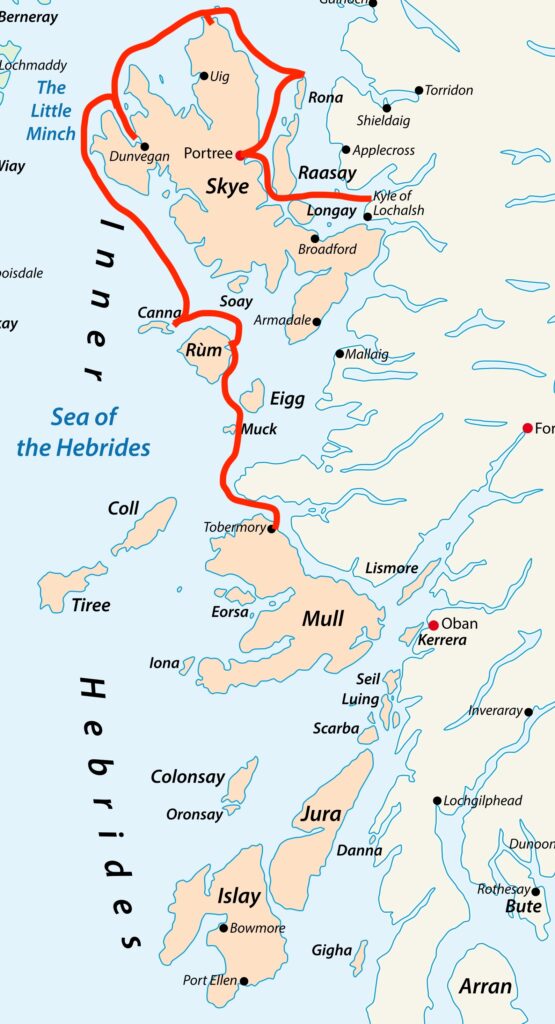
After several hours huddled in the basement of the youth hostel taking advantage of a rare find of laundry machines, we put on our nicest clean clothes in search for a dinner venue. Surprisingly, most were booked up for the night. When we did find one that was first come-first serve, we happily diverted to the pub side of the restaurant along with an obvious collection of other couples, all hydrating as we waited for our name to be called. Despite the variety of look and feel of the restaurants in town, their menus were decidedly predictable with the common Scottish fare – fish and chips (of course), steak and ale pie, and a variety of burger options. If you were hoping for a salad, you might get booted out by the barmaid. Our name was finally announced and we followed a harried waitress to our table, a skinny two-chair spot barely big enough for two place settings and only inches from another couple. Whether we wanted to or not, we were now dining with a couple hailing from Holland. Any attempt to have a private conversation was wasted energy. They turned out to be charming and this gave us a brief porthole into the life of a land traveller in these parts as they recounted the challenges of getting to this rugged island without the aid of a private car hire. Equally, we left them with a few stories to tell of the odd American couple that had to travel on a little open rubber boat back out in the dark to their yacht in the harbor to garner sleep for the night.


There are several great hikes within a short bus ride from Portree, and our hiking legs needed some reinvigorating since the days of healthy elevation gains in Norway, but headwinds were in the forecast. To get around the top of Skye before the winds had a chance to beat us back, we needed to press on. The Sound of Raasay, the body of water between Skye and its slender island neighbor of Raasay was the challenge we needed to get back into tactical sailing. Long, narrow and directly in line with the wind, we had our work cut out for us. We unfurled both sails immediately after raising our anchor, trimming them in tight for a close-hauled course across the Sound. A bulking catamaran, hobble-horsing in the ocean swell – was having a hard time holding their course to windward, feeling the struggle of every cat owner. It’s all good. Next time we see them, they will likely have 15 people onboard, partying and swimming in warm tropical waters where catamaran’s rule the roost for comfort and socializing.

At the top of Raasay is a little baby island named Rona with a harbor attractively protected from the north winds. After our many tacks were done and we had mastered the upwind work for the day, we entered the skinny harbor entrance, keeping an eagle eye on the chart-plotter, backed up with a spotter on the bow. There were two bends in the harbor entrance that both had sizeable rocks just below the surface that were not marked with buoys. We pulled up new charts that we had downloaded from a group of boaters who had taken the time to survey this and many other tricky harbors in Scotland with their own craft. This was the first time we used their data, and to say it was ‘priceless’ would have been an understatement. It showed important detail where the official government charts, which can be many decades old, were painfully lacking. In the case of Rona, we would not have taken the risk of entering with just the official charts alone.
Ashore, we were beguiled once again by the use of an honesty box, not only for the payment of the mooring fee but also for a variety of self-serve items, including two haddock fillets out of the mini-fridge which would fit right into our modified dinner plan. On a hike across the island, soaking up sunshine that seemed to defy the clouds clinging to the land and sea all around Rona, we met the delightful couple that manages the island (and supplies the meat and fish in the mini-fridge). This was not a pair of academics on a summer fling assignment. They had been managing the operation year round for several years. With its isolated location, you could understand if they were cautious and reserved. Yet, here was a couple as chatty as any elbow mate at a pub in Portree. It was inspirational to meet someone with such a palpable sense of groundedness and resolve.


All of our tacking the previous day had put us far enough north that we could strike out back across to Skye with the possibility of just a single tack. We dropped the mooring at 7am to be sure we had enough time for the passage and before the forecasted wind shifted to an unfavorable northwest direction. It was off to the races immediately. Shortly, we were heeled over enough to take a reef in the genoa and main. Still, Sea Rose sliced through the water, full of big swells now that we had no protection from the open ocean to the north. The coastline of Skye in this region is dominated by striking cliffs that drop vertically to the water, including one section called Meale Kitt that has a waterfall emptying out all of the rain from the high mountain interior. The wind was so strong, it was blowing this waterfall completely sideways, leaving just misty wet cliff walls on the downwind side.


The sky had turned cloudy and dark gray. When I scanned the horizon in all directions, we were the only boat, pleasure or commercial, save for a small skiff taking the inshore route at high speed, white water firing sideways off its bow, as it appeared to hustle to the next small harbor along this rugged coast. At the northern extreme of Skye, a spot named Rubha Hunish, the chart warned of overfalls, the unpleasantness of standing waves resulting from wind against current. We found this and more unpleasantries, such as whirlpools that made it hard to hold on to the wheel, let alone steer a straight course. As we turned around the point, the wind was at our back and, like in a haunted house, I didn’t want to look behind us, out of fear that the big ugly monster of breaking waves might be planning a sneak attack. Mercifully, our planned anchorage for the night was right around the corner, at Duntulum Bay, and as if on cue, the sky was clearing for our arrival, apart from a dramatic mountain peak in the distance enshrouded mystically in a fast flowing cloud layer. One other smaller boat was already anchored, though they soon left and with a pile of people emerging from the cabin below, including a young woman in a tank top and shorts as if ready to stroll the boardwalk on a hot summer day in New Jersey. They raised anchor and departed while we looked on, head to toe in foul weather gear and multiple insulating layers underneath. To be young!


Despite the challenges of the day’s sail and the beautiful weather we were left with after our arrival, we had to watch from onboard the boat as hikers explored the beautiful scenery; there was no safe place for us to land the dinghy, and a strong current through the anchorage would have made it difficult to relax on shore. But we had much to celebrate, having rounded the northern end of Skye. If the weather forecast held, it might be like climbing the stairs at the park’s big play structure, and getting ready for the reward of a long ride down the slide.
And blessed we were. In the morning we motored away from the anchorage and raised our hard-to-miss fluorescent pink asymmetrical spinnaker in a light following breeze, carrying it nearly the full distance to Dunvegan Castle, where we exchanged energetic arm-waves from a passing boat. When I looked closer, it was the same boat from Duntulum Bay, and the boardwalk bride had now swapped out the crop top for a bikini. I suppose she could have hailed from Norway and felt like Scotland was the tropics. I ditched my wool hat in solemn tribute!

If we could have done a quick name change to Macleod, we could have saved the entry fee at the Dunvegan Castle, the base of the Macleod clan. Instead, we joined all of the other commoners in awe at the extravagance of Scottish nobility.

With time to spare for a little boat maintenance, I opened up our anchor windlass to fix a misbehaving sensor. What I found instead was excessive corrosion, the result of stainless steel and aluminum which don’t get along very well in a saltwater environment. This galvanic corrosion is a well known issue in the boating world. Both metals have an important role to play on a boat, but when they are built side-by-side, there usually is a membrane or at least an anti-corrosion coating applied to both surfaces. I hurriedly ordered a replacement part for our next guests to bring with them from the States and gingerly put the windlass back together.
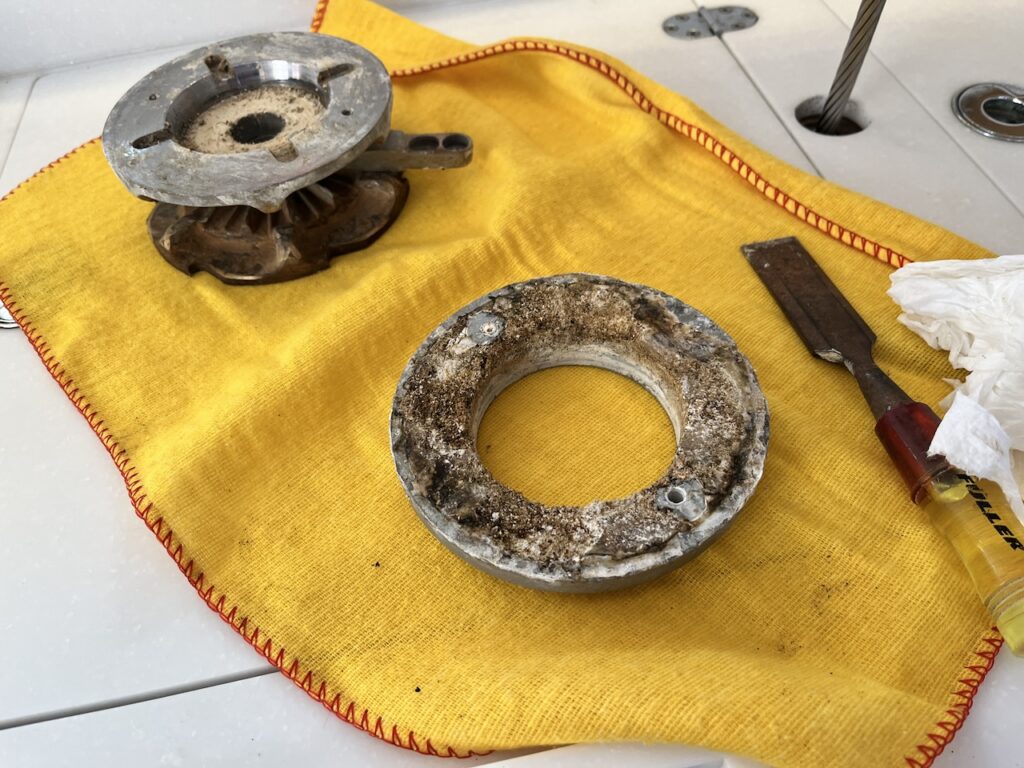
The western side of Skye is dominated by large, angular cliffs that look like the ski jumps for the spiritual gods of the island. Deeply green soil led right to the edge of the sea and despite a windless, gray day, there was beauty all around. In some ways, it felt more mysterious and vivid than our days of full sunshine.
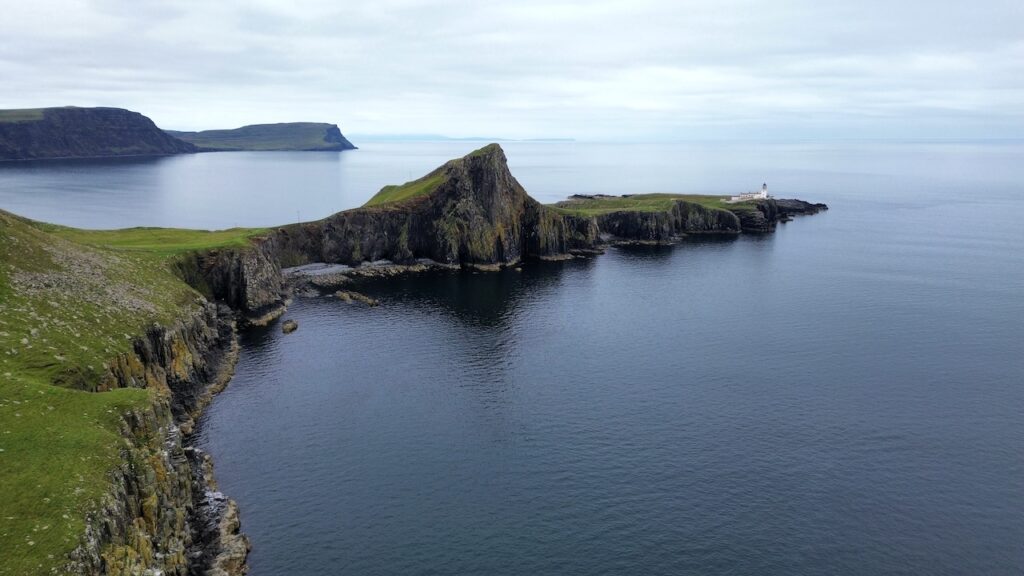
It was time for us to let go of Skye’s grip and continue south, back to the Small Isles Group – this time to the island of Canna. We could see if off our bow in the distance–a long, low lying island that seemed, despite the chartplotter telling us it was three hours away, much closer. In fact, it has several tall peaks; we were cursed by the reality that tall islands on the horizon make their presence known long before you are close to them, teasing you with the anticipation.
Passing one of Canna’s peaks, Compass Hill, so named because of the frequency of magnetic anomalies in the area, we set our anchor in the nearly enclosed harbor and promptly launched the dinghy to discover this new island. Remoteness means a lot of different things to different people. If being out of cell phone range is remote, than Canna has that in spades. I had an important meeting to call in to back in the States and no cell service had me reaching for our satellite phone. Thankfully, we found another ‘honesty’ shop ashore, this time decked out with a wide variety of fresh, frozen and dry goods, a cash box to put your bills into, a credit card machine ready to tap, and a handy calculator to save yourself time adding everything up in your head. Once more, they had a small office work space overlooking the harbor with free wifi. Problem solved!


Canna is actually comprised of two islands, the later of which, Sanday, extended out to the south with rolling fields abundant with tall grasses, bogs, and little hilltop crests perfect for an afternoon of hiking when the goal is sightseeing not cardiac arrest. We ran into a cheerful tour boat captain who recommended we hike to the very southern tip of Sanday where the view over a pair of sea stacks offshore is dominated by a colony of puffins. This was not a trail on par with the signage standards of Norway; thus, we lost our way several times and considered abandoning the puffin hunt as the daylight started to fade. But finally we arrived at the designated spot, with, remarkably, a long earthen mound in the perfect dimension of a bench seat, carved out from years of wind and rain. Like junior members of the Louis Leakey Society, we both sat in awe as we observed huge flocks of puffins wheeling about above the sea stack, putting on what seemed like a private acrobatic airshow for our viewing pleasure. As we carefully grabbed our cameras–but otherwise stayed silent–puffins would swoop by us, closer and closer each time, likely assuming that we were part of the natural landscape. There have been a few times in my life where I felt if I were to die the next day I would have found ultimate contentment. This was one of them.

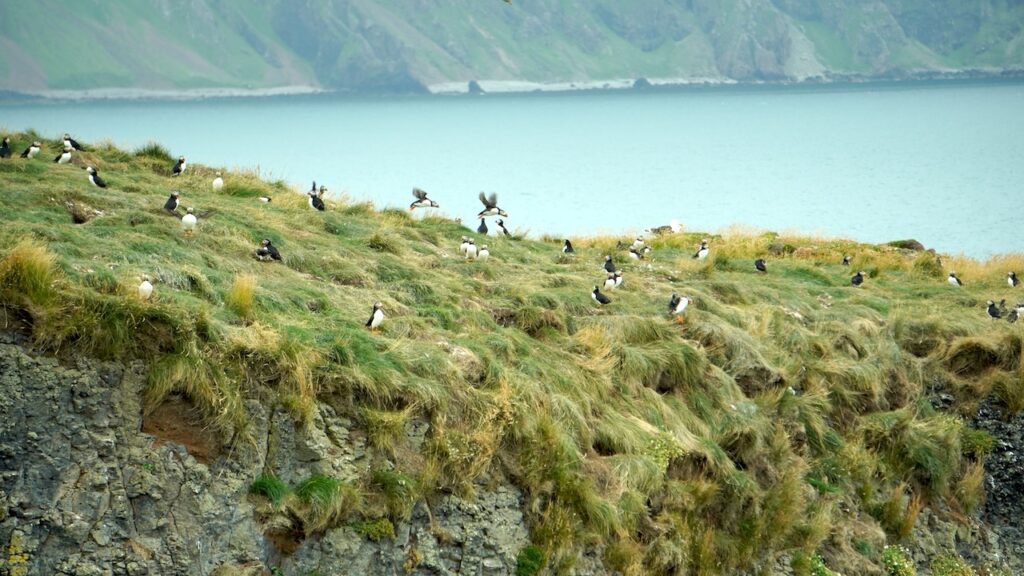
But no one was dying anytime soon. There were plenty more islands to discover. Adjacent to Canna is the much more mountainous island of Rum. And, let’s face it, with a name like that, you can’t consciously just sail on by without stopping. The harbor at Kinlock was wide open to the East but thankfully the strong winds forecasted for the next 24 hours were all out of the south or west. We launched the dinghy and landed at an old stone pier with uneven steps to the top, missing enough stones to make it feel authentically last-century old. It was at least as old as Queen Victoria’s generation. Kinloch Castle, once the extravagant money pit of textile tycoon Sir George Bullough in 1900, it was the site of many scandalous parties, having a ballroom designed with no windows and a double hatch entrance to the bar to avoid the prying eyes of servants. Rumor has it that Queen Victoria’s grown children were regular guests. Today it is fenced off and slowly succumbing to the elements, without a buyer willing to revive its past, or attract a more well-behaved clientele.
Every island has its story. For us, Rum turned out to be a fine place for a multi-hour hike following a creek into the lush interior, as we exchanged greetings with many other hiking couples, singles and larger groups. If they harbored any past scandalous secrets, they had struck a fine balance with the invigorating pleasures of nature.
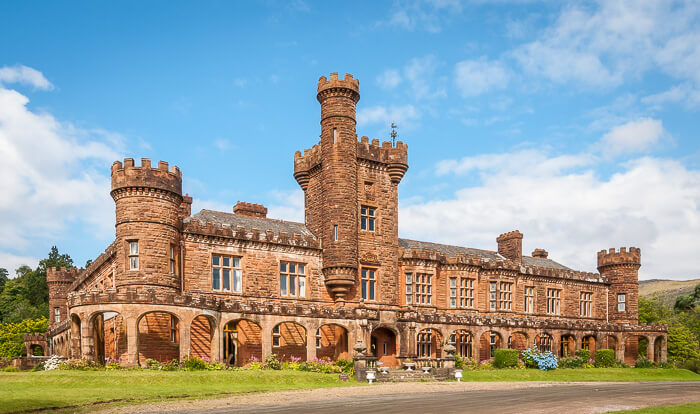

With strong winds from the south, right in the direction we needed to head to our next destination of Tobermory, it was time to get serious. In the morning, after a sleepless night worrying about the possibility of other boats anchored nearby dragging down on us, we set both sails under a sky full of clouds and a steady rain, preparing mentally for a day of tacking upwind. When the waves are not too out of control, as they were on this passage, it’s not such a bad experience working one’s way upwind as long as there is time in the schedule for it. Cutting 45 degree paths across the direct line to our destination is a task best timed when there is an extra helping of patience in your soul.

Finally, we took our last tack around Ardnamurchan Point, not far from our run-in the previous week with a long floating black pipe. Behind the protection of Muck Island, the water was flat but the wind still strong, giving us a glorious last blast of a sail at over 8 knots. Tobermory is a very popular, centrally located stop along the Western Scotland sailing route. The natural harbor is ample in size, the pastel painted waterfront oozes charm, and, oh, also, there is the fine Tobermory whiskey distillery. They keep things simple by only making two whiskeys, one of which has a locally distinctive heavy smoky flavor, a result of burning peat in the process of drying the malted barley. With just two choices, it made our tour and tasting pretty succinct, like when my Dad used to make me a sandwich, asking if I wanted bologna or salami. It was indeed a simpler time back then. But of course there were important items missing, like seatbelts.
In search–as I often find myself–of a decent hardware store, I came across Brown’s Merchants along the waterfront drag with a respectable assortment of tools in the front window. What I missed was the previous window was an assortment of whiskies, probably thinking in my mind that it was an adjacent liquor store. But no. Here at Brown’s ‘We have been selling whiskey and hardware since 1830’, the polite woman at the counter announced proudly to a man in angst trying to select the right single malt gift to take home. For me, it was a large phillips-head screwdriver, and, no thanks, I’ll skip the personalized whiskey recommendations. What could possibly go wrong with a dram in one hand and a power tool in the other? Clearly our education on Scottish culture had some important gaps to fill!


